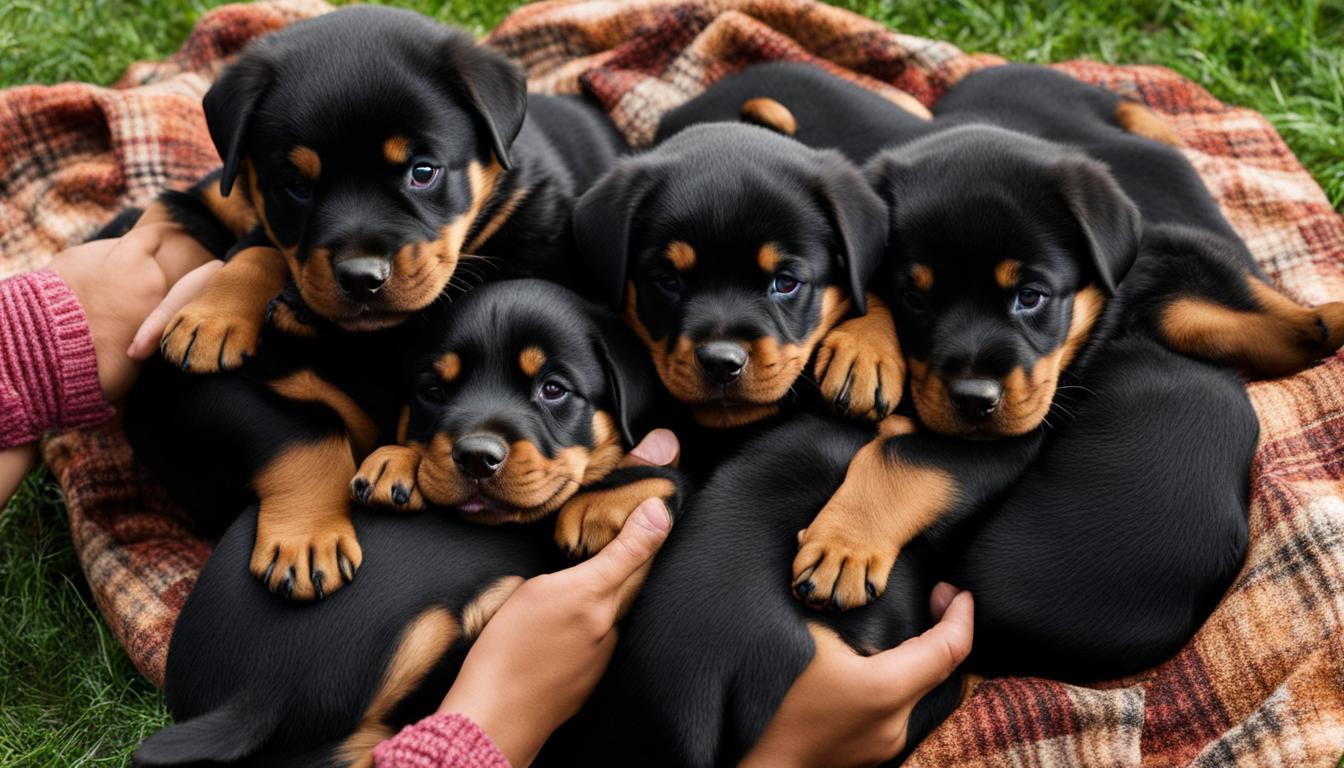Choosing a Rottweiler puppy from a litter requires careful consideration to ensure a lifelong bond with a pup that fits your family and lifestyle.
Understanding Rottweiler Puppy Temperament and Behavior
Rottweiler puppies have unique temperament and behavior traits essential when selecting a new furry family member.
Importance of Social Behavior in Selection
Social behavior is crucial in determining a Rottweiler puppy’s suitability for your lifestyle. Puppies with well-developed social skills are more likely to adapt to various environments and interact positively with humans and other animals.
When choosing a Rottweiler puppy, observe how they engage with their littermates and their behavior in group settings. Look for puppies with confidence, curiosity, and a willingness to engage with others.
Assessing Response to Human Interaction
Assessing a Rottweiler puppy’s response to human interaction is essential for predicting their future behavior. A puppy that approaches and interacts willingly with humans demonstrates sociability and friendliness.
Observe their body language for signs of confidence, such as a relaxed posture, a wagging tail, and curiosity toward new stimuli. Avoid puppies with fear or aggression towards humans, as these behaviors can be challenging.
Deciphering Puppy Play Dynamics in a Litter
Puppy play dynamics within a litter can provide valuable insights into their future behavior and temperament. Watch how puppies engage with each other during playtime.
Notice if they take turns, share toys, and communicate through appropriate play behaviors such as play-bowing and chasing. Puppies that demonstrate good play manners and respond well to corrections from their littermates are more likely to have balanced, well-mannered personalities.

How to Pick a Rottweiler Puppy from a Litter
When picking a Rottweiler puppy, you must take a thoughtful approach to ensure you find the perfect fit for your family.
Follow these steps and use the puppy evaluation checklist provided below to make an informed decision:
Evaluate Health: Start by assessing the overall health of the puppies in the litter. Keep an eye out for indications of well-being in your pet, like lively and clear eyes, well-maintained ears, and a sleek, shiny coat. Avoid puppies that appear lethargic, have discharge from their eyes or nose, or show any signs of illness.
Assess Temperament: Observe each puppy’s behavior to understand their temperament. Look for puppies that are curious, friendly, and eager to interact. Avoid puppies that are overly shy, aggressive, or show signs of fearfulness.
Consider Conformation: Rottweilers have specific breed standards regarding their physical structure and appearance. Look for puppies with well-proportioned bodies, strong bones, and a confident posture. Avoid puppies with conformational defects or structural issues.
Check for Suitability: Consider your lifestyle and what you’re looking for in a Rottweiler puppy. Are you looking for a family pet, a show dog, or a working companion? Ensure the puppy’s characteristics align with your specific needs and expectations.
Evaluating the Health of a Rottweiler Puppy
Let’s explore the essential aspects to remember when evaluating a Rottweiler puppy’s health.
Signs of a Healthy Puppy: Coat, Eyes, and Ears
A shiny and well-maintained coat is a sign of a healthy Rottweiler puppy. Look for a coat that is clean, free from matting, and has a vibrant color. Their eyes should be bright, clear, and free from discharge or redness.
Additionally, check their ears for cleanliness and odor, as these can indicate the absence of infections or mites. By evaluating these visible signs, you can get an initial understanding of the puppy’s overall health.
Common Hereditary Health Issues in Rottweilers
Rottweilers are predisposed to specific hereditary health issues that potential owners should be aware of. These may include conditions such as degenerative myelopathy, cardiac disease, and certain forms of cancer.
While not all Rottweilers will develop these conditions, it’s essential to discuss the medical history of the puppy’s parents with the breeder.
Understanding this information can assist you in gauging the probability of inherited health issues and empower you to make a thoughtful choice regarding the puppy’s well-being.
Understanding Hip Dysplasia Risks and Prevention
Hip dysplasia is an orthopedic condition that affects Rottweilers. It occurs when the hip joint is improperly formed, leading to discomfort, pain, and mobility issues later in life.
Evaluating the risk of hip dysplasia in a Rottweiler puppy involves considering the health certifications of the parents, as well as their hip scores.
Following responsible breeding practices, a breeder will conduct necessary health screenings, such as hip X-rays, to ensure their breeding dogs are free from hip dysplasia.
Additionally, it is essential to provide proper nutrition, exercise, and regular veterinary check-ups to prevent the onset or progression of hip dysplasia.

The Role of the Puppy’s Parents in Selection
When choosing a Rottweiler puppy, it is essential to consider the role of the puppy’s parents in the selection process. The temperament and health of the parents can provide valuable insights into the potential traits and characteristics of the puppy.
Consider their level of obedience and trainability, as this can influence the ease of training your new puppy.
Assessing the health of the parents is equally important. Look for parents free from genetic health issues and have undergone relevant health screenings. This can help minimize the risk of inheriting certain health conditions, providing your puppy with the best possible start in life.
Additionally, consider the physical characteristics of the parents. Evaluate their conformation, size, and build to understand what the puppy may look like as an adult.
When selecting a puppy based on their parents, gathering information from the breeder and asking questions about the parent’s temperament, health, and lineage is crucial. A reputable breeder will be transparent and forthcoming with this information.
| Factors to Consider | Impact on Puppy Selection |
|---|---|
| Temperament of the parents | Gives insights into the puppy’s likely behavior and disposition |
| Health of the parents | Minimizes the risk of inheriting genetic health issues |
| Physical characteristics of the parents | Gives an idea of what the puppy may look like as an adult |
Physical Characteristics and Breed Standards
Rottweiler puppies have distinct physical characteristics that define the breed and adhere to specific breed standards.
Analyzing Puppy Conformation: Proportion and Structure
When analyzing a Rottweiler puppy’s conformation, factors such as proportion and structure play a crucial role. Proportion refers to the overall balance and symmetry of the puppy’s body, specifically the relationship between different body parts.
Structure focuses on the puppy’s skeletal alignment and musculature. Evaluating these aspects can provide valuable insights into the puppy’s potential for notable physical development as it grows into adulthood.
Marking Patterns and Breeding Criteria
In addition to conformation, Rottweiler puppies’ marking patterns also contribute to their physical characteristics. Breeders often consider specific markings and patterns when selecting puppies for breeding purposes. These markings can range from specific color patterns on the face and body to the distribution of tan points.
Puppy Coat Types and What They Indicate About Adulthood
Rottweiler puppies exhibit different coat types, which can indicate their future adulthood appearance. The breed standard recognizes two primary coat types: the outer coat and the undercoat. The outer coat is typically coarse and dense, while the undercoat is softer and serves as insulation.

Preparing to Bring Your Rottweiler Puppy Home
Here are some essential steps to take before bringing your Rottweiler puppy home:
Puppy Supplies Checklist: Gather all the necessary supplies to meet your puppy’s basic needs. This includes food and water bowls, high-quality puppy food, a leash, a collar with identification tags, a comfortable bed, chew toys, grooming supplies, and a crate for crate training.
Puppy-Proofing Your Home: Create a safe environment by puppy-proofing your home. Remove potential hazards such as toxic plants, chemicals, electrical cords, and small objects that could be swallowed. Secure cabinets, block off-limits areas, and ensure no escape routes.
Safe Space: Set up a designated area in your home where your Rottweiler puppy can feel safe and secure. This can be a crate, a playpen, or a puppy-proofed room with a comfortable bed and some toys.
Potty Training: Decide on the potty training method you will use and prepare the necessary supplies. This may include pee pads, a designated outdoor potty area, or a litter box for apartment living.
Establish a Routine: Dogs thrive on routine, so start establishing a schedule for feeding, potty breaks, playtime, training, and rest. Consistency is vital in helping your puppy adjust and feel secure in their new home.
Trusted Breeders and Ethical Breeding Practices
A reputable breeder prioritizes their puppies’ well-being and future, ensuring they are healthy, well-socialized, and bred with care. To make the right choice, there are several key factors to consider.
What to Look for in a Rottweiler Breeder
Firstly, look for a breeder with a solid reputation and extensive experience in breeding Rottweilers.
They should be knowledgeable about the breed, actively involved in dog shows or performance events, and able to provide references from other satisfied puppy owners. An ethical breeder will be open and transparent, inviting you to visit their facilities and meet the puppies’ parents.
The Importance of Health and Temperament Screening
Health and temperament screening are crucial aspects of responsible breeding. A reputable breeder will conduct health checks on the parent dogs, including tests for genetic disorders common in Rottweilers.
Likewise, they will assess the temperament and behavior of the parents to ensure they possess the desirable traits. This screening process helps ensure that the puppies have a lower risk of inheriting health issues and will have the desired temperament.
Questions to Ask and Red Flags to Avoid
When communicating with potential breeders, be prepared with a list of questions to ask. Inquire about the puppies’ medical history, vaccination records, and any guarantees or contracts the breeder provides.
A trustworthy breeder will gladly provide this information and answer any questions. Be wary of red flags such as breeders who offer multiple breeds, have many litters available, or seem unwilling to provide proper documentation or references.
FAQ
How do I choose the right Rottweiler puppy from a litter?
Choosing the right Rottweiler puppy involves considering factors such as temperament, health, physical characteristics, and the role of the puppy’s parents in selection.
It’s essential to assess the puppy’s response to human interaction and observe the dynamics of puppy play within the litter. Using a puppy evaluation checklist can help you make an informed decision.
What should I look for in the temperament and behavior of Rottweiler puppies?
When selecting a Rottweiler puppy, consider their social behavior and response to human interaction. A well-rounded and sociable puppy will adapt more to different environments and experiences. Observing puppy play within the litter can also give you insights into their temperament and behavior patterns.
How can I pick a Rottweiler puppy from a litter?
You can use a puppy evaluation checklist to pick a Rottweiler puppy from a litter. This checklist will guide you through assessing key factors such as health, temperament, conformation, and overall suitability for your needs.
What are the signs of a healthy Rottweiler puppy?
Signs of a healthy Rottweiler puppy include a shiny coat, bright eyes, and clean ears. The puppy should be active, alert, and have a good appetite. It’s also essential to inquire about the puppy’s medical history and any health clearances from the breeder. Regular veterinary check-ups are crucial to maintaining the puppy’s health.
How important are the parents in selecting a Rottweiler puppy?
The parents of a Rottweiler puppy play a significant role in determining their temperament and health. Evaluating the temperament and health of both the sire (father) and dam (mother) can provide insights into the potential traits and characteristics of the puppy. Understanding the parents’ backgrounds lets you decide the puppy’s future development.
What should I consider regarding physical characteristics and breed standards when choosing a Rottweiler puppy?
When selecting a Rottweiler puppy, analyze their proportions and structure. Look for markings and breeding criteria that align with breed standards. Additionally, consider the different coat types and how they may indicate the puppy’s appearance in adulthood. These factors contribute to the overall quality and adherence to breed standards.
How can I prepare to bring a Rottweiler puppy home?
To prepare for bringing a Rottweiler puppy home, create a checklist of essential supplies such as food, water bowls, a bed, and appropriate toys. Puppy-proofing your home is necessary to ensure a safe environment. Remove all hazardous items and secure any areas that could be problematic for a curious and energetic puppy.
What should I look for in a Rottweiler breeder?
When looking for a Rottweiler breeder, consider their adherence to ethical breeding practices. Look for breeders who prioritize the health and temperament of their dogs and perform thorough health and temperament screenings.
Asking questions about the breeder’s practices and inquiring about the puppy’s parents can help you determine if they are reputable and responsible.
